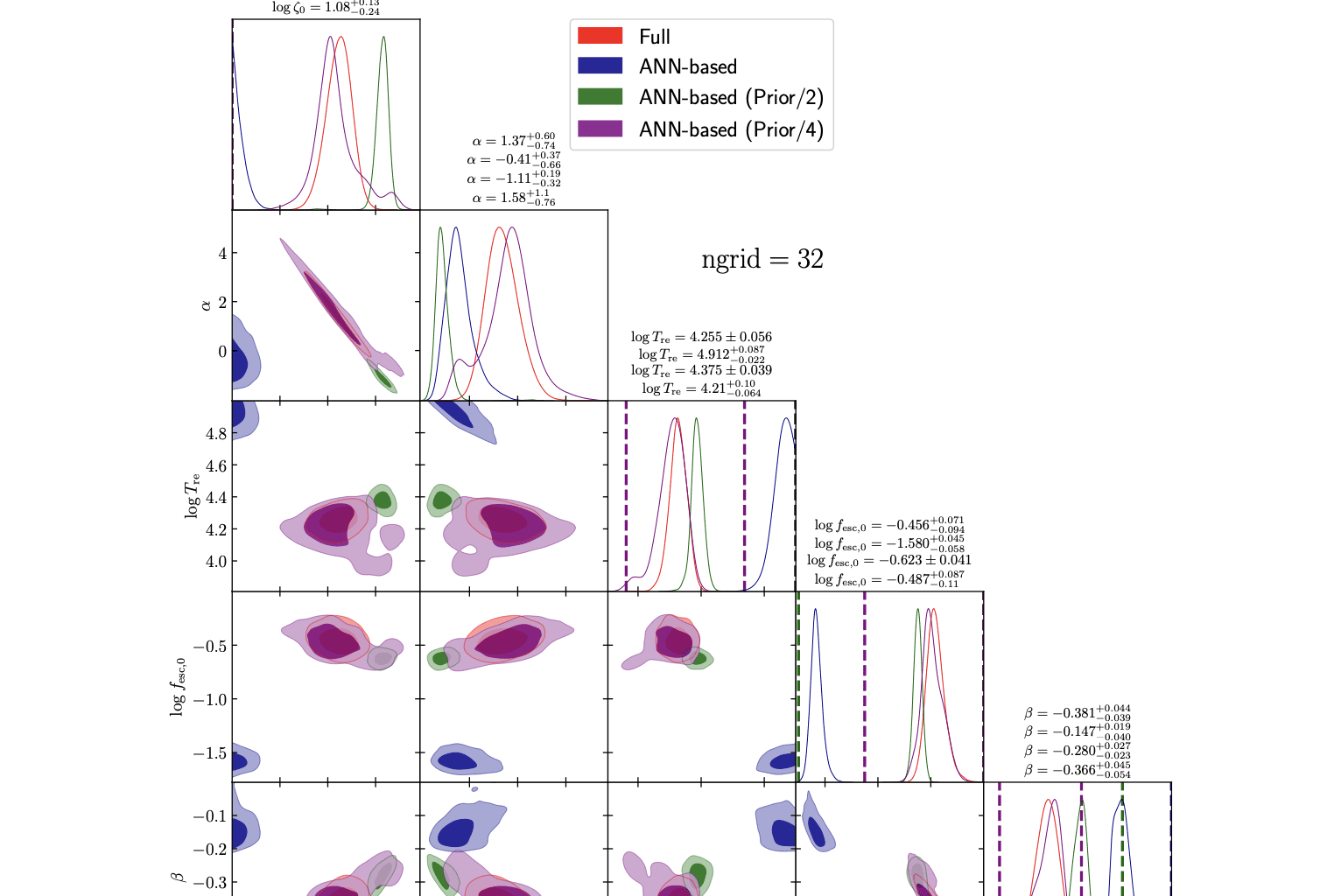Understanding the Epoch of Reionization, a pivotal moment when the universe emerged from darkness, presents a significant challenge for cosmologists, demanding extensive computational resources. Saptarshi Sarkar and Tirthankar Roy Choudhury, from the National Centre for Radio Astrophysics, Tata Institute of Fundamental Research, alongside their colleagues, now present a solution, developing a new framework that dramatically accelerates the process of extracting meaningful constraints from simulations. Their approach leverages the power of artificial neural networks to create an ‘emulator’ of a complex cosmological model, significantly reducing the number of computationally expensive simulations required for accurate analysis. This breakthrough achieves remarkable speedups, lowering computational costs by factors of up to 500, and opens the door to exploring much more detailed and realistic models, incorporating data from telescopes like the James Webb Space Telescope and future 21cm observatories.
Scientists present an efficient emulator-based framework that dramatically reduces computational bottlenecks for analyzing the Epoch of Reionization, a crucial period in the universe’s history when the intergalactic medium transitioned from neutral to ionized. Their approach combines a reliable coarse-resolution Markov Chain Monte Carlo (MCMC) method to locate high-likelihood regions with an adaptive, targeted sampling strategy to build a compact, high-resolution training set for an artificial neural network-based emulator of the model likelihood. With approximately 103 high-resolution simulations, the trained emulators achieve excellent predictive accuracy, exhibiting R2 values of approximately 0. 97, 0. 99, and reproduce posterior distributions from full high-resolution simulations when embedded within an MCMC framework.
Early Universe Reionization and IGM Modelling
A comprehensive body of research explores the physics of the early universe, reionization, and the intergalactic medium (IGM). Many studies focus on the epoch of reionization, investigating the sources of ionizing radiation, the timing of this transition, and its impact on the IGM. Researchers model star formation in high-redshift galaxies and analyze the end of reionization using observations from the Lyman-alpha forest and quasar spectra. Significant attention is also given to the thermal history of the IGM, including its temperature, density, and ionization state, through analysis of the Lyman-alpha forest.
Researchers also explore the formation and evolution of large-scale structures in the universe and aim to constrain cosmological parameters using various observational probes. Numerical simulations, employing codes like GADGET, are crucial for understanding the complex physics involved, particularly modeling radiative transfer. Increasingly, machine learning and advanced statistical techniques are being applied to cosmological data analysis. Neural networks are used for emulation, training to approximate the results of computationally expensive simulations, and for inference, extracting cosmological parameters from observational data.
Techniques like density estimation, using normalizing flows, and image generation, employing diffusion models, are also gaining prominence. Bayesian statistical methods, including Markov Chain Monte Carlo, are used for parameter estimation and model comparison, utilizing tools like Cobaya and GetDist. Active learning efficiently selects simulations to maximize information gained, and fast likelihood-free cosmology methods are being developed. The convergence of these areas is accelerating progress. Machine learning speeds up simulations by replacing them with fast, accurate approximations, improves inference by handling complex data, and helps marginalize over uncertainties in astrophysical processes. Machine learning also generates realistic mock observations for testing analysis pipelines and validating results. This collection of research demonstrates a field undergoing a transformation, with machine learning augmenting traditional methods to deliver faster, more accurate, and more robust results.
Efficiently Exploring The Epoch of Reionization
Scientists developed a new framework to efficiently explore the Epoch of Reionization, a crucial period in the universe’s history when the intergalactic medium transitioned from neutral to ionized. The work addresses a significant computational bottleneck in analyzing this era, traditionally requiring extensive simulations that become impractical as model complexity increases. The team achieved a substantial reduction in computational cost by combining a coarse-resolution Markov chain Monte Carlo (MCMC) method with an artificial neural network-based emulator. Initial experiments utilized Latin hypercube sampling to generate a broad set of simulations, allowing researchers to identify high-likelihood regions within the parameter space.
This preliminary exploration informed a targeted sampling strategy, constructing a compact, high-resolution training set for the neural network emulator. Results demonstrate the emulator achieves excellent predictive accuracy, with performance reaching 99% fidelity when compared to full, high-resolution simulations. When integrated into an MCMC framework, the emulator reproduces posterior distributions equivalent to those obtained from complete simulations, validating its accuracy and reliability. This approach enables tractable inference in complex models, providing a general strategy for building efficient emulators for next-generation Epoch of Reionization constraints. This advancement promises to accelerate our understanding of this pivotal period in cosmic evolution.
Neural Network Emulator Speeds Reionization Parameter Estimation
This research presents a new framework for efficiently estimating parameters governing the Epoch of Reionization, a crucial period in the universe’s evolution when the intergalactic medium transitioned from neutral to ionized. The team developed an emulator based on artificial neural networks that dramatically reduces the computational cost of parameter inference, a traditionally slow process requiring numerous simulations. By combining a coarse initial search with targeted sampling to create a compact training dataset, the emulator accurately predicts simulation outcomes with high fidelity. The results demonstrate a significant speedup, reducing the number of expensive simulations by a factor of one thousand and lowering overall computational cost by up to a factor of one hundred, while maintaining statistical accuracy. Future work will focus on refining the sampling strategies and exploring more advanced machine learning architectures to further improve the efficiency and accuracy of parameter inference for increasingly complex models of the Epoch of Reionization.
👉 More information
🗞 Accelerating Reionization Constraints: An ANN-Emulator Framework for the SCRIPT Semi-numerical Model
🧠 ArXiv: https://arxiv.org/abs/2511.16256

